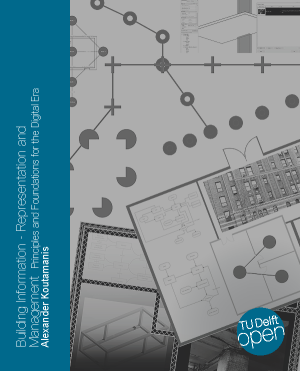Building Information - Representation and Management: Principles and Foundations for the Digital Era
Synopsis
The book presents a coherent theory of building information, focusing on its representation and management in the digital era. It addresses issues such as the information explosion and the structure of analogue building representations to propose a parsimonious approach to the deployment and utilization of symbolic digital technologies like BIM. It also considers the matching representation of AECO processes in terms of tasks, so as to connect to information processing and support both information management and decision taking.
Downloads
References
Attneave, F., 1959. Applications of information theory to psychology; a summary of basic concepts, methods, and results. New York: Holt.
Blair, A. et al. (eds.), 2021, Information: a historical companion. Princeton: Princeton University Press.
Bytheway, A., 2014. Investing in information. New York: Springer.
Chabris, C. F., & Simons, D. J., 2010. The invisible gorilla : and other ways our intuitions deceive us. New York: Crown.
Cosgrove, D., 2003. Ptolemy and Vitruvius: spatial representation in the sixteenth-century texts and commentaries. A. Picon & A. Ponte (eds) Architecture and the sciences: exchanging metaphors. Princeton NJ: Princeton University Press.
Cover, T.M., & Thomas, J.A., 2006. Elements of information theory (2nd ed.). Hoboken NJ: Wiley-Interscience.
Dean, J., & Ghemawat, J., 2008. “MapReduce: simplified data processing on large clusters” Commun. ACM 51, 1 (January 2008), 107–113, https://doi.org/10.1145/1327452.1327492
Detlor, B., 2010. Information management. International Journal of Information Management, 30(2), 103-108. doi:10.1016/j.ijinfomgt.2009.12.001
Eastman, C., Teicholz, P.M., Sacks, R., & Lee, G., 2018. BIM handbook (3rd ed.). Hoboken NJ: Wiley.
Emmitt, S., 2014. Design management for architects (2nd ed.). Hoboken NJ: Wiley.
English, L.P., 1999. Improving data warehouse and business information quality: methods for reducing costs and increasing profits. New York: Wiley.
Evans, J. S. B. T., & Frankish, K. (2009). In two minds : dual processes and beyond. Oxford: Oxford University Press.
Evans, R., 1995. The Projective Cast: Architecture and Its Three Geometries. Cambridge MA: MIT Press.
Eynon, J., 2013. The design manager’s handbook. Southern Gate, Chichester, West Sussex, UK: CIOB, John Wiley & Sons.
Flett, A., 2011. Information management possible?:Why is information management so difficult? Business Information Review, 28(2), 92-100. doi:10.1177/0266382111411066
Floridi, L., 2008. Trends in the philosophy of information. P. Adriaans & J. v. Benthem (eds), Philosophy of information. Amsterdam: North-Holland.
Floridi, L., 2009. Philosophical conceptions of information. G. Sommaruga (ed), Formal Theories of Information: From Shannon to semantic information theory and general concepts of information. Berlin, Heidelberg: Springer.
Floridi, L., 2014. The fourth revolution. Oxford: Oxford University Press.
Floridi, L., 2016. Semantic conceptions of information. The Stanford Encyclopedia of Philosophy. https://plato.stanford.edu/entries/information-semantic/
Flyvbjerg, B., 2011. Over Budget, Over Time, Over and Over Again: Managing Major Projects. In Morris, P.W. G; Pinto, JK; Söderlund, J. (eds.), The Oxford Handbook of Project Management. Oxford: Oxford University Press.
Gantz, J. & Reinsel, D., 2011. “Extracting value from chaos.” 2011, https://www.emc.com/collateral/analyst-reports/idc-extracting-value-from-chaos-ar.pdf
Gawande, A., 2010. The checklist manifesto : how to get things right. New York: Metropolitan Books.
Goodman, N., 1976. Languages of art; an approach to a theory of symbols (2nd ed.). Indianapolis IN: Hackett.
Graham, M., & Dutton, W.H. (eds.), 2019. Society and the Internet. Oxford: Oxford University Press.
Kahneman, D., 2013. Thinking, fast and slow. New York: Farrar, Straus and Giroux.
Kanizsa, G., 1979. Organization in vision: essays on Gestalt perception. New York: Praeger.
Klein, G. A., 1998. Sources of power : how people make decisions. Cambridge MA: MIT Press.
Koutamanis, A., 2020. Dimensionality in BIM: Why BIM cannot have more than four dimensions? Automation in Construction, 114, 2020, 103153, https://doi.org/10.1016/j.autcon.2020.103153
Koutamanis, A., et al., 2018. Urban mining and buildings. Resources, Conservation and Recycling, 138(November), 32-39 https://doi.org/10.1016/j.resconrec.2018.06.024
Levine, T. R., 2014. Truth-Default Theory (TDT): A Theory of Human Deception and Deception Detection. Journal of Language and Social Psychology, 33(4), 378–392. https://doi.org/10.1177/0261927X14535916
Lyman, P. & Varian, H.P. 2003, “How much information.” http://groups.ischool.berkeley.edu/archive/how-much-info/
Pierce, J.R., 1980. An introduction to information theory : symbols, signals & noise (2nd, rev. ed.). New York: Dover.
Rider, F., 1944, The Scholar and the Future of the Research Library. New York: Hadham Press.
Richards, M., 2010. Building Information Management – a standard framework and guide to BS 1192. London: BSI.
Rosenfeld, L., Morville, P., & Arango, J., 2015. Information architecture: for the web and beyond (4th ed.). Sebastopol CA: O’Reilly Media.
Shannon, C., 1948. A mathematical theory of communication. Bell System Technical Journal, 27(July, October), 379-423, 623-656.
Shannon, C.E., & Weaver, W., 1998. The mathematical theory of communication. Urbana IL: University of Illinois Press.
Simonite, T., 2016. “Moore’s law Is dead. Now what?” Technology Review https://www.technologyreview.com/s/601441/moores-law-is-dead-now-what/
Sommaruga, G., 2009. Introduction. G. Sommaruga (ed.), Formal Theories of Information: From Shannon to semantic information theory and general concepts of information. Berlin, Heidelberg: Springer.
Stanovich, K. E., 2011. Rationality and the reflective mind. New York: Oxford University Press.
Steadman, P., 1983. Architectural morphology: an introduction to the geometry of building plans. London: Pion.
Thaler, R. H., & Sunstein, C. R., 2021. Nudge: the final edition. New Haven: Yale University Press.
Toffler, A., 1970. Future shock. New York: Random House.
Turner, V., Reinsel D., Gantz J. F., & Minton S., 2014. “The Digital Universe of Opportunities” https://www.emc.com/leadership/digital-universe/2014iview/digital-universe-of-opportunities-vernon-turner.htm
Van Sommers, P., 1984. Drawing and cognition: descriptive and experimental studies of graphic production processes. Cambridge: Cambridge University Press.
Wang, R.Y., & Strong, D.M., 1996. Beyond accuracy: what data quality means to data consumers. Journal of Management Information Systems, 12(4), 5-33. doi:10.1080/07421222.1996.11518099
Waltz, D., 1975. Understanding line drawings of scenes with shadows. P.H. Winston (ed) The psychology of computer vision. New York: McGraw-Hill.
Zins, C., 2007. Conceptual approaches for defining data, information, and knowledge. Journal of the American Society for Information Science and Technology. 58(4) 479-493 DOI: 10.1002/asi.20508.

Published
License

This work is licensed under a Creative Commons Attribution-NonCommercial-ShareAlike 4.0 International License.


